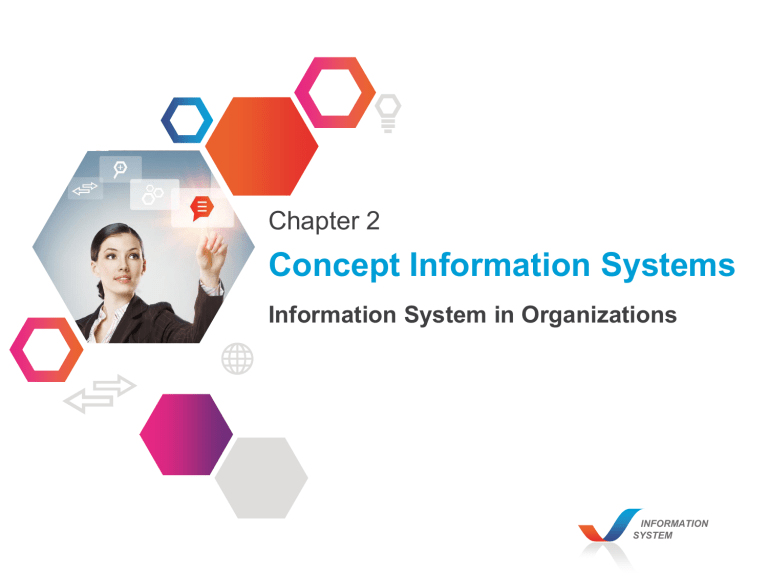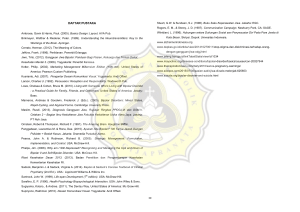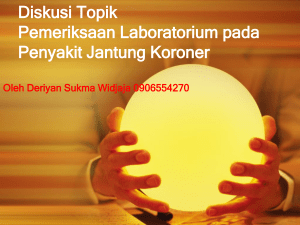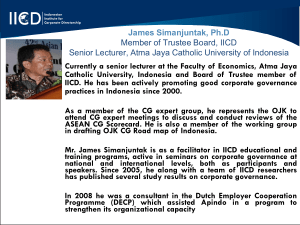Concept Information Systems Information System in Organizations
advertisement

Chapter 2 Concept Information Systems Information System in Organizations INFORMATION SYSTEM Information System in Organizations Learning Objectives Mengidentifikasi proses nilai tambah (value-added) dalam rantai pasokan (supply chain) dan menggambarkan peran sistem informasi. Memberikan definisi yang jelas tentang istilah struktur organisasi, budaya, dan perubahan dan mendiskusikan bagaimana mereka mempengaruhi pelaksanaan sistem informasi. Mengidentifikasi beberapa strategi yang digunakan untuk menurunkan biaya atau meningkatkan layanan. Mendefinisikan keunggulan kompetitif jangka panjang dan membahas bagaimana organisasi menggunakan sistem informasi untuk mendapatkan keuntungan tersebut. Menentukan jenis peran, fungsi, dan karir yang tersedia di bidang sistem informasi. O’Brien, J., & James A. 2010. Introduction to information systems (15th ed.). New York: McGraw-Hill/Irwin. O’Brien, J., & James A. 2011. Management Information Systems (10th ed.). New York: McGraw-Hill/Irwin. Ralph M. Stair and George W. Reynolds. 2010 . Principles of Information Systems A Managerial Approach, 9th ed. Boston. R. Kelly Rainer Jr. and Casey G. Cegielski John. 2011. Introduction to Information Systems, Third Edit. John Wiley & Sons, Inc, INFORMATION SYSTEM Information System in Organizations Subtopic Organizations and Information Systems Organizational Structures Organizational Culture and Change Reengineering and Continuous Improvement Outsourcing, On-Demand Computing, and Downsizing Competitive Advantage Factors That Lead Firms to Seek Competitive Advantage Strategic Planning for Competitive Advantage Performance-Based Information Systems Productivity Return on Investment and the Value of Information Systems Careers in Information Systems Roles, Functions, and Careers in IS O’Brien, J., & James A. 2010. Introduction to information systems (15th ed.). New York: McGraw-Hill/Irwin. O’Brien, J., & James A. 2011. Management Information Systems (10th ed.). New York: McGraw-Hill/Irwin. Ralph M. Stair and George W. Reynolds. 2010 . Principles of Information Systems A Managerial Approach, 9th ed. Boston. R. Kelly Rainer Jr. and Casey G. Cegielski John. 2011. Introduction to Information Systems, Third Edit. John Wiley & Sons, Inc, INFORMATION SYSTEM Organizations And Information Systems Definition Organizations Organisasi yaitu Sebuah koleksi formal orang dan sumber daya lain yang dibentuk untuk mencapai serangkaian tujuan. Misalkan, Tujuan utama dari sebuah organisasi nirlaba adalah untuk memaksimalkan nilai pemegang saham, sering diukur oleh harga saham perusahaan. Organisasi terus-menerus menggunakan uang, orang, bahan, mesin dan peralatan lainnya, data, informasi, dan keputusan. Melalui menambahkan nilai atau harga, organisasi berusaha untuk mencapai tujuan mereka. O’Brien, J., & James A. 2010. Introduction to information systems (15th ed.). New York: McGraw-Hill/Irwin. O’Brien, J., & James A. 2011. Management Information Systems (10th ed.). New York: McGraw-Hill/Irwin. Ralph M. Stair and George W. Reynolds. 2010 . Principles of Information Systems A Managerial Approach, 9th ed. Boston. R. Kelly Rainer Jr. and Casey G. Cegielski John. 2011. Introduction to Information Systems, Third Edit. John Wiley & Sons, Inc, INFORMATION SYSTEM Organizations And Information Systems General Model Organisasi O’Brien, J., & James A. 2010. Introduction to information systems (15th ed.). New York: McGraw-Hill/Irwin. O’Brien, J., & James A. 2011. Management Information Systems (10th ed.). New York: McGraw-Hill/Irwin. Ralph M. Stair and George W. Reynolds. 2010 . Principles of Information Systems A Managerial Approach, 9th ed. Boston. R. Kelly Rainer Jr. and Casey G. Cegielski John. 2011. Introduction to Information Systems, Third Edit. John Wiley & Sons, Inc, INFORMATION SYSTEM Organizations And Information Systems The Value Chain of a Manufacturing Company Value chain Serangkaian dari kegiatan yang mencakup logistik, gudang dan penyimpanan, produksi, penyimpanan produk jadi, pemasaran dan penjualan, dan layanan pelanggan. Value Mungkin berarti harga yang lebih rendah , layanan yang lebih baik , kualitas yang lebih tinggi, atau keunikan produk . value berasal dari keterampilan, pengetahuan , waktu , dan energi bahwa perusahaan berinvestasi dalam produk atau kegiatan . O’Brien, J., & James A. 2010. Introduction to information systems (15th ed.). New York: McGraw-Hill/Irwin. O’Brien, J., & James A. 2011. Management Information Systems (10th ed.). New York: McGraw-Hill/Irwin. Ralph M. Stair and George W. Reynolds. 2010 . Principles of Information Systems A Managerial Approach, 9th ed. Boston. R. Kelly Rainer Jr. and Casey G. Cegielski John. 2011. Introduction to Information Systems, Third Edit. John Wiley & Sons, Inc, INFORMATION SYSTEM Organizations And Information Systems The Value Chain of a Manufacturing Company O’Brien, J., & James A. 2010. Introduction to information systems (15th ed.). New York: McGraw-Hill/Irwin. O’Brien, J., & James A. 2011. Management Information Systems (10th ed.). New York: McGraw-Hill/Irwin. Ralph M. Stair and George W. Reynolds. 2010 . Principles of Information Systems A Managerial Approach, 9th ed. Boston. R. Kelly Rainer Jr. and Casey G. Cegielski John. 2011. Introduction to Information Systems, Third Edit. John Wiley & Sons, Inc, INFORMATION SYSTEM Organizational Structures Definition ? Organizational Structures / Struktur organisasi Subunit organisasi dan cara mereka berhubungan dengan organisasi secara keseluruhan. Struktur organisasi tergantung pada tujuan dan pendekatan manajemen, dan dapat mempengaruhi bagaimana memandang dan menggunakan sistem informasi. Jenis-jenis struktur organisasi: Traditional Organizational Structure Project and Team Organizational Structures Virtual Organizational Structure and Collaborative Work O’Brien, J., & James A. 2010. Introduction to information systems (15th ed.). New York: McGraw-Hill/Irwin. O’Brien, J., & James A. 2011. Management Information Systems (10th ed.). New York: McGraw-Hill/Irwin. Ralph M. Stair and George W. Reynolds. 2010 . Principles of Information Systems A Managerial Approach, 9th ed. Boston. R. Kelly Rainer Jr. and Casey G. Cegielski John. 2011. Introduction to Information Systems, Third Edit. John Wiley & Sons, Inc, INFORMATION SYSTEM Organizational Structures Traditional Organizational Structure Sebuah struktur organisasi di mana kepala departemen melapor kepada presiden atau manajer tingkat atas. disebut juga struktur hirarki, seperti piramida manajerial di mana hirarki pengambilan keputusan dan wewenang mengalir dari manajemen strategis di bagian atas turun ke manajemen operasional dan karyawan nonmanagement. Sebuah model sederhana dari organisasi, yang menunjukkan piramida manajerial dari tingkat manajer puncak untuk karyawan non-manajemen. O’Brien, J., & James A. 2010. Introduction to information systems (15th ed.). New York: McGraw-Hill/Irwin. O’Brien, J., & James A. 2011. Management Information Systems (10th ed.). New York: McGraw-Hill/Irwin. Ralph M. Stair and George W. Reynolds. 2010 . Principles of Information Systems A Managerial Approach, 9th ed. Boston. R. Kelly Rainer Jr. and Casey G. Cegielski John. 2011. Introduction to Information Systems, Third Edit. John Wiley & Sons, Inc, INFORMATION SYSTEM Organizational Structures Traditional Organizational Structure O’Brien, J., & James A. 2010. Introduction to information systems (15th ed.). New York: McGraw-Hill/Irwin. O’Brien, J., & James A. 2011. Management Information Systems (10th ed.). New York: McGraw-Hill/Irwin. Ralph M. Stair and George W. Reynolds. 2010 . Principles of Information Systems A Managerial Approach, 9th ed. Boston. R. Kelly Rainer Jr. and Casey G. Cegielski John. 2011. Introduction to Information Systems, Third Edit. John Wiley & Sons, Inc, INFORMATION SYSTEM Organizational Structures Project and Team Organizational Structures Struktur organisasi yang berpusat pada produk utama atau jasa. Sebagai contoh, dalam sebuah perusahaan manufaktur yang memproduksi makanan bayi dan produk bayi lainnya, setiap baris yang dihasilkan oleh unit terpisah. Fungsi tradisional seperti pemasaran, keuangan, dan produksi yang diposisikan dalam unit-unit utama. Banyak tim proyek bersifat sementara. Struktur organisasi tim berpusat pada tim kerja atau kelompok. O’Brien, J., & James A. 2010. Introduction to information systems (15th ed.). New York: McGraw-Hill/Irwin. O’Brien, J., & James A. 2011. Management Information Systems (10th ed.). New York: McGraw-Hill/Irwin. Ralph M. Stair and George W. Reynolds. 2010 . Principles of Information Systems A Managerial Approach, 9th ed. Boston. R. Kelly Rainer Jr. and Casey G. Cegielski John. 2011. Introduction to Information Systems, Third Edit. John Wiley & Sons, Inc, INFORMATION SYSTEM Organizational Structures Project and Team Organizational Structures O’Brien, J., & James A. 2010. Introduction to information systems (15th ed.). New York: McGraw-Hill/Irwin. O’Brien, J., & James A. 2011. Management Information Systems (10th ed.). New York: McGraw-Hill/Irwin. Ralph M. Stair and George W. Reynolds. 2010 . Principles of Information Systems A Managerial Approach, 9th ed. Boston. R. Kelly Rainer Jr. and Casey G. Cegielski John. 2011. Introduction to Information Systems, Third Edit. John Wiley & Sons, Inc, INFORMATION SYSTEM Organizational Structures Virtual Organizational Structure Struktur Organisasi yang mempekerjakan individu, kelompok, atau unit bisnis yang lengkap di daerah geografis yang dapat berlangsung selama beberapa minggu atau tahun, sering membutuhkan telekomunikasi atau internet. Tim virtual yang berpartisipasi untuk memecahkan masalah organisasi. O’Brien, J., & James A. 2010. Introduction to information systems (15th ed.). New York: McGraw-Hill/Irwin. O’Brien, J., & James A. 2011. Management Information Systems (10th ed.). New York: McGraw-Hill/Irwin. Ralph M. Stair and George W. Reynolds. 2010 . Principles of Information Systems A Managerial Approach, 9th ed. Boston. R. Kelly Rainer Jr. and Casey G. Cegielski John. 2011. Introduction to Information Systems, Third Edit. John Wiley & Sons, Inc, INFORMATION SYSTEM Organizational Culture and Change Culture, Organizational Culture and organizational change Culture seperangkat pemahaman utama dan asumsi bersama oleh sebuah kelompok , seperti dalam suatu kelompok etnis atau negara . Organizational Culture terdiri dari pemahaman utama dan asumsi untuk bisnis, perusahaan, atau organisasi lain. pemahaman ini dapat mencakup kepercayaan umum, nilai-nilai, dan pendekatan untuk pengambilan keputusan. Organizational change berkaitan dengan bagaimana organisasi merencanakan, melaksanakan, dan menangani perubahan. perubahan dapat disebabkan oleh : faktor internal, seperti yang diprakarsai oleh karyawan di semua tingkatan, atau faktor eksternal, seperti kegiatan yang ditimbulkan oleh pesaing, pemegang saham, undang-undang, peraturan masyarakat, kejadian alam (seperti badai), dan kondisi umum ekonomi. O’Brien, J., & James A. 2010. Introduction to information systems (15th ed.). New York: McGraw-Hill/Irwin. O’Brien, J., & James A. 2011. Management Information Systems (10th ed.). New York: McGraw-Hill/Irwin. Ralph M. Stair and George W. Reynolds. 2010 . Principles of Information Systems A Managerial Approach, 9th ed. Boston. R. Kelly Rainer Jr. and Casey G. Cegielski John. 2011. Introduction to Information Systems, Third Edit. John Wiley & Sons, Inc, INFORMATION SYSTEM Reengineering and Continuous Improvement Reengineering ? Untuk tetap kompetitif, organisasi harus sesekali melakukan perubahan mendasar dalam cara mereka melakukan bisnis. Dengan kata lain, mereka harus mengubah kegiatan, tugas, atau proses yang mereka gunakan untuk mencapai tujuan mereka. Reengineering (process redesign) disain ulang radikal suatu proses bisnis, struktur organisasi, sistem informasi, dan nilai-nilai organisasi untuk mencapai terobosan dalam hasil bisnis. O’Brien, J., & James A. 2010. Introduction to information systems (15th ed.). New York: McGraw-Hill/Irwin. O’Brien, J., & James A. 2011. Management Information Systems (10th ed.). New York: McGraw-Hill/Irwin. Ralph M. Stair and George W. Reynolds. 2010 . Principles of Information Systems A Managerial Approach, 9th ed. Boston. R. Kelly Rainer Jr. and Casey G. Cegielski John. 2011. Introduction to Information Systems, Third Edit. John Wiley & Sons, Inc, INFORMATION SYSTEM Reengineering and Continuous Improvement Reengineering ? O’Brien, J., & James A. 2010. Introduction to information systems (15th ed.). New York: McGraw-Hill/Irwin. O’Brien, J., & James A. 2011. Management Information Systems (10th ed.). New York: McGraw-Hill/Irwin. Ralph M. Stair and George W. Reynolds. 2010 . Principles of Information Systems A Managerial Approach, 9th ed. Boston. R. Kelly Rainer Jr. and Casey G. Cegielski John. 2011. Introduction to Information Systems, Third Edit. John Wiley & Sons, Inc, INFORMATION SYSTEM Reengineering and Continuous Improvement Continuous Improvement ? Continuous Improvement Terus-menerus mencari cara untuk meningkatkan proses bisnis untuk menambah nilai produk dan jasa. Perubahan terus-menerus ini akan meningkatkan kepuasan dan loyalitas pelanggan dan memastikan keuntungan jangka panjang. O’Brien, J., & James A. 2010. Introduction to information systems (15th ed.). New York: McGraw-Hill/Irwin. O’Brien, J., & James A. 2011. Management Information Systems (10th ed.). New York: McGraw-Hill/Irwin. Ralph M. Stair and George W. Reynolds. 2010 . Principles of Information Systems A Managerial Approach, 9th ed. Boston. R. Kelly Rainer Jr. and Casey G. Cegielski John. 2011. Introduction to Information Systems, Third Edit. John Wiley & Sons, Inc, INFORMATION SYSTEM Reengineering and Continuous Improvement Comparing Business Process Reengineering and Continuous Improvement O’Brien, J., & James A. 2010. Introduction to information systems (15th ed.). New York: McGraw-Hill/Irwin. O’Brien, J., & James A. 2011. Management Information Systems (10th ed.). New York: McGraw-Hill/Irwin. Ralph M. Stair and George W. Reynolds. 2010 . Principles of Information Systems A Managerial Approach, 9th ed. Boston. R. Kelly Rainer Jr. and Casey G. Cegielski John. 2011. Introduction to Information Systems, Third Edit. John Wiley & Sons, Inc, INFORMATION SYSTEM Outsourcing, On-Demand Computing, and Downsizing Outsourcing ? Outsourcing Kontrak dengan layanan profesional luar untuk memenuhi kebutuhan bisnis yang spesifik. Sebagian besar biaya organisasi digunakan untuk menyewa, melatih, dan kompensasi staf berbakat. Organisasi mencoba untuk mengendalikan biaya dengan menentukan jumlah karyawan yang mereka butuhkan untuk mempertahankan barang dan jasa berkualitas tinggi. O’Brien, J., & James A. 2010. Introduction to information systems (15th ed.). New York: McGraw-Hill/Irwin. O’Brien, J., & James A. 2011. Management Information Systems (10th ed.). New York: McGraw-Hill/Irwin. Ralph M. Stair and George W. Reynolds. 2010 . Principles of Information Systems A Managerial Approach, 9th ed. Boston. R. Kelly Rainer Jr. and Casey G. Cegielski John. 2011. Introduction to Information Systems, Third Edit. John Wiley & Sons, Inc, INFORMATION SYSTEM Outsourcing, On-Demand Computing, and Downsizing On-demand computing ? On-demand computing perluasan dari pendekatan outsourcing persetujuan untuk sumber daya komputer untuk secara cepat merespon berbagai alur kerja organisasi. Juga disebut on-demand bisnis dan utilitas komputasi. Hal ini sering disebut komputasi utilitas karena organisasi membayar untuk sumber daya komputasi dari konsultan perusahaan, seperti membayar listrik dari perusahaan utilitas/penyedia layanan. Pendekatan ini memperlakukan sistem termasuk hardware, software, database , telekomunikasi, personel, dan lain Dengan kata lain, bukan membeli hardware, software, dan sistem database, tetapi organisasi hanya membayar biaya untuk pemakaian sistem yang dibutuhkan. Pendekatan ini dapat menghemat uang karena organisasi tidak membayar untuk sistem yang tidak secara rutin perlu. Hal ini juga memungkinkan IS staf organisasi untuk berkonsentrasi pada isu-isu yang lebih strategis . O’Brien, J., & James A. 2010. Introduction to information systems (15th ed.). New York: McGraw-Hill/Irwin. O’Brien, J., & James A. 2011. Management Information Systems (10th ed.). New York: McGraw-Hill/Irwin. Ralph M. Stair and George W. Reynolds. 2010 . Principles of Information Systems A Managerial Approach, 9th ed. Boston. R. Kelly Rainer Jr. and Casey G. Cegielski John. 2011. Introduction to Information Systems, Third Edit. John Wiley & Sons, Inc, INFORMATION SYSTEM Outsourcing, On-Demand Computing, and Downsizing Downsizing ? Downsizing Mengurangi jumlah karyawan untuk memotong biaya. Perampingan melibatkan mengurangi jumlah karyawan untuk memotong biaya. Daripada memilih proses bisnis yang spesifik untuk berhemat, perusahaan biasanya melihat ke berhemat di seluruh perusahaan. Perampingan jelas mengurangi total biaya gaji, meskipun semangat kerja karyawan dapat menderita. O’Brien, J., & James A. 2010. Introduction to information systems (15th ed.). New York: McGraw-Hill/Irwin. O’Brien, J., & James A. 2011. Management Information Systems (10th ed.). New York: McGraw-Hill/Irwin. Ralph M. Stair and George W. Reynolds. 2010 . Principles of Information Systems A Managerial Approach, 9th ed. Boston. R. Kelly Rainer Jr. and Casey G. Cegielski John. 2011. Introduction to Information Systems, Third Edit. John Wiley & Sons, Inc, INFORMATION SYSTEM Competitive Advantage Definition ? Competitive Advantage Manfaat jangka panjang yang signifikan dan (idealnya) untuk perusahaan selama kompetisi dan dapat menghasilkan produkproduk berkualitas tinggi, layanan pelanggan yang lebih baik, dan biaya yang lebih rendah. Membangun dan mempertahankan keunggulan kompetitif itu kompleks, tapi kelangsungan hidup dan kemakmuran perusahaan bergantung pada keberhasilannya dalam melakukannya. Suatu organisasi sering menggunakan sistem informasi untuk membantu mencapai keunggulan kompetitif. O’Brien, J., & James A. 2010. Introduction to information systems (15th ed.). New York: McGraw-Hill/Irwin. O’Brien, J., & James A. 2011. Management Information Systems (10th ed.). New York: McGraw-Hill/Irwin. Ralph M. Stair and George W. Reynolds. 2010 . Principles of Information Systems A Managerial Approach, 9th ed. Boston. R. Kelly Rainer Jr. and Casey G. Cegielski John. 2011. Introduction to Information Systems, Third Edit. John Wiley & Sons, Inc, INFORMATION SYSTEM Competitive Advantage Factors That Lead Firms to Seek Competitive Advantage Faktor-faktor Yang Memimpin Perusahaan untuk Mencari Keunggulan Kompetitif, Lima kekuatan menurut Michael Porter meliputi yaitu: Rivalry Among Existing Competitors / Rivalitas antara Pesaing yang Ada Threat of New Entrants / Ancaman pendatang baru Threat of Substitute Products and Services / Ancaman produk dan jasa pengganti, Bargaining Power of Customers and Suppliers / Kekuatan tawar pembeli, dan Kekuatan tawar-menawar pemasok. O’Brien, J., & James A. 2010. Introduction to information systems (15th ed.). New York: McGraw-Hill/Irwin. O’Brien, J., & James A. 2011. Management Information Systems (10th ed.). New York: McGraw-Hill/Irwin. Ralph M. Stair and George W. Reynolds. 2010 . Principles of Information Systems A Managerial Approach, 9th ed. Boston. R. Kelly Rainer Jr. and Casey G. Cegielski John. 2011. Introduction to Information Systems, Third Edit. John Wiley & Sons, Inc, INFORMATION SYSTEM Competitive Advantage Factors That Lead Firms to Seek Competitive Advantage Rivalry Among Existing Competitors Biasanya, industri yang sangat kompetitif dicirikan oleh tingginya biaya tetap, dan memiliki banyak pesaing. Industri dengan persaingan yang lebih kuat cenderung sebuah perusahaan yang selalu mencari keunggulan kompetitif. Untuk mendapatkan keuntungan lebih dari pesaing, perusahaan terus menganalisa bagaimana mereka menggunakan sumber daya dan aset mereka. Pandangan berbasis sumber daya (resource-based view) ini adalah sebuah pendekatan untuk memperoleh dan mengendalikan aset atau sumber daya yang dapat membantu perusahaan mencapai keunggulan kompetitif. Sebagai contoh, sebuah perusahaan transportasi mungkin memutuskan untuk berinvestasi menggunakan teknologi frekuensi radio (radio-frequency technology) untuk menandai dan melacak produk ketika mereka bergerak dari satu lokasi ke lokasi lain. Threat of New Entrants Ancaman yang muncul dari pesaing baru yang muncul. Sebagai contoh, sebuah restoran kecil terancam oleh pesaing baru terutama restoran yang bersekala besar. Ketika ancaman pemain baru/pesaing baru yang tinggi, keinginan untuk mencari dan mempertahankan keunggulan kompetitif untuk berusaha menghalangi pendatang baru juga biasanya semakin tinggi. O’Brien, J., & James A. 2010. Introduction to information systems (15th ed.). New York: McGraw-Hill/Irwin. O’Brien, J., & James A. 2011. Management Information Systems (10th ed.). New York: McGraw-Hill/Irwin. Ralph M. Stair and George W. Reynolds. 2010 . Principles of Information Systems A Managerial Approach, 9th ed. Boston. R. Kelly Rainer Jr. and Casey G. Cegielski John. 2011. Introduction to Information Systems, Third Edit. John Wiley & Sons, Inc, INFORMATION SYSTEM Competitive Advantage Factors That Lead Firms to Seek Competitive Advantage Threat of Substitute Products and Services Perusahaan yang menawarkan satu jenis barang atau jasa akan terancam oleh perusahaan-perusahaan lain yang menawarkan barang atau jasa serupa. contoh, perhatikan industri fotografi. Ketika kamera digital menjadi populer, perusahaan film tradisional harus merespon untuk tetap kompetitif dan menguntungkan. Perusahaan film tradisional, seperti Kodak dan lain-lain, mulai menawarkan produk tambahan dan meningkatkan pelayanan, seperti halnya kamera digital, meningkatkan kemampuan untuk menghasilkan gambar digital. Bargaining Power of Customers and Suppliers Pelanggan besar cenderung mempengaruhi perusahaan, dan pengaruh ini dapat meningkat secara signifikan jika pelanggan dapat mengancam untuk beralih ke perusahaan saingan. Ketika pelanggan memiliki banyak daya tawar, perusahaan harus meningkatkan keunggulan kompetitif mereka untuk mempertahankan pelanggan mereka. Demikian pula, ketika daya tawar pemasok yang kuat, perusahaan perlu meningkatkan keunggulan kompetitif mereka untuk mempertahankan posisi tawar mereka. O’Brien, J., & James A. 2010. Introduction to information systems (15th ed.). New York: McGraw-Hill/Irwin. O’Brien, J., & James A. 2011. Management Information Systems (10th ed.). New York: McGraw-Hill/Irwin. Ralph M. Stair and George W. Reynolds. 2010 . Principles of Information Systems A Managerial Approach, 9th ed. Boston. R. Kelly Rainer Jr. and Casey G. Cegielski John. 2011. Introduction to Information Systems, Third Edit. John Wiley & Sons, Inc, INFORMATION SYSTEM Competitive Advantage Strategic Planning for Competitive Advantage Cost leadership. Memberikan biaya serendah mungkin untuk produk dan layanan. Cost leadership sering dicapai dengan mengurangi biaya bahan baku melalui perundingan agresif dengan pemasok, menjadi lebih efisien dengan proses produksi dan manufaktur, dan mengurangi pergudangan dan biaya pengiriman. Beberapa perusahaan menggunakan outsourcing untuk memotong biaya ketika memproduksi produk atau memberikan layanan jasa. Differentiation. Memberikan produk dan layanan yang berbeda. Strategi ini dapat melibatkan memproduksi berbagai produk, memberikan pelanggan lebih banyak pilihan, atau menghasilkan produk dan layanan berkualitas tinggi. O’Brien, J., & James A. 2010. Introduction to information systems (15th ed.). New York: McGraw-Hill/Irwin. O’Brien, J., & James A. 2011. Management Information Systems (10th ed.). New York: McGraw-Hill/Irwin. Ralph M. Stair and George W. Reynolds. 2010 . Principles of Information Systems A Managerial Approach, 9th ed. Boston. R. Kelly Rainer Jr. and Casey G. Cegielski John. 2011. Introduction to Information Systems, Third Edit. John Wiley & Sons, Inc, INFORMATION SYSTEM Competitive Advantage Strategic Planning for Competitive Advantage Altering the industry structure/Mengubah struktur industri. Mengubah industri untuk menjadi lebih menguntungkan bagi perusahaan atau organisasi. Creating new products and services/Menciptakan produk dan layanan baru. Memperkenalkan produk dan layanan baru secara berkala atau sering. Strategi ini selalu membantu sebuah perusahaan mendapatkan keuntungan kompetitif, terutama untuk industri komputer dan bisnis berteknologi tinggi lainnya. Improving existing product lines and services/Meningkatkan lini produk dan jasa yang ada. Melakukan perbaikan yang nyata atau dianggap lini produk dan jasa yang ada. Produsen produk rumah tangga selalu iklan produk baru dan lebih baik. O’Brien, J., & James A. 2010. Introduction to information systems (15th ed.). New York: McGraw-Hill/Irwin. O’Brien, J., & James A. 2011. Management Information Systems (10th ed.). New York: McGraw-Hill/Irwin. Ralph M. Stair and George W. Reynolds. 2010 . Principles of Information Systems A Managerial Approach, 9th ed. Boston. R. Kelly Rainer Jr. and Casey G. Cegielski John. 2011. Introduction to Information Systems, Third Edit. John Wiley & Sons, Inc, INFORMATION SYSTEM Performance-Based Information Systems Bisnis telah melewati setidaknya tiga tahapan utama dalam penggunaan sistem informasi . Pada tahap pertama , organisasi berfokus pada penggunaan sistem informasi untuk mengurangi biaya dan meningkatkan produktivitas . Tahap kedua didefinisikan oleh Porter. Organisasi harus berorientasi memperoleh keunggulan kompetitif. Pada tahap ketiga ini , perusahaan harus berhati hati-hati mempertimbangkan baik keuntungan strategis dan biaya. O’Brien, J., & James A. 2010. Introduction to information systems (15th ed.). New York: McGraw-Hill/Irwin. O’Brien, J., & James A. 2011. Management Information Systems (10th ed.). New York: McGraw-Hill/Irwin. Ralph M. Stair and George W. Reynolds. 2010 . Principles of Information Systems A Managerial Approach, 9th ed. Boston. R. Kelly Rainer Jr. and Casey G. Cegielski John. 2011. Introduction to Information Systems, Third Edit. John Wiley & Sons, Inc, INFORMATION SYSTEM Performance-Based Information Systems Return on Investment and the Value of Information Systems Earnings Growth/pertumbuhan laba Ukuran lain nilai IS adalah peningkatan laba, istem mendatangkan atau pertumbuhan laba. Market Share and Speed to Market Market Share (Pangsa pasar) adalah kemampuan perusahaan menguasai pasar. Sistem informasi juga dapat membantu organisasi membawa produk dan layanan kepada pelanggan baru dalam waktu yang relatif singkat. Customer Awareness and Satisfaction Meskipun kepuasan pelanggan bisa sulit untuk dihitung, sekitar setengah dari perusahaan terbaik global saat ini mengukur kinerja sistem informasi mereka berdasarkan umpan balik dari pengguna internal dan eksternal. O’Brien, J., & James A. 2010. Introduction to information systems (15th ed.). New York: McGraw-Hill/Irwin. O’Brien, J., & James A. 2011. Management Information Systems (10th ed.). New York: McGraw-Hill/Irwin. Ralph M. Stair and George W. Reynolds. 2010 . Principles of Information Systems A Managerial Approach, 9th ed. Boston. R. Kelly Rainer Jr. and Casey G. Cegielski John. 2011. Introduction to Information Systems, Third Edit. John Wiley & Sons, Inc, INFORMATION SYSTEM Careers In Information Systems Keterampilan penting bagi pekerja IS adalah sebagai berikut: Machine learning Mobilizing applications Wireless networking Human-computer interface Project management General networking skills Network convergence technology Open-source programming Business intelligence systems Embedded security Digital home technology integration Languages, including C#, C++, and Java O’Brien, J., & James A. 2010. Introduction to information systems (15th ed.). New York: McGraw-Hill/Irwin. O’Brien, J., & James A. 2011. Management Information Systems (10th ed.). New York: McGraw-Hill/Irwin. Ralph M. Stair and George W. Reynolds. 2010 . Principles of Information Systems A Managerial Approach, 9th ed. Boston. R. Kelly Rainer Jr. and Casey G. Cegielski John. 2011. Introduction to Information Systems, Third Edit. John Wiley & Sons, Inc, INFORMATION SYSTEM Information System in Organizations Summary Penggunaan sistem informasi untuk menambah nilai organisasi sangat dipengaruhi oleh struktur organisasi, budaya, dan perubahan. Karena sistem informasi sangat penting, bisnis harus yakin bahwa perbaikan atau sistem yang sama sekali baru membantu menurunkan biaya, meningkatkan keuntungan, meningkatkan layanan, atau mencapai keunggulan kompetitif. Kerjasama antara manajer bisnis dan IS personil adalah kunci untuk membuka potensi dari setiap sistem baru atau diubah. O’Brien, J., & James A. 2010. Introduction to information systems (15th ed.). New York: McGraw-Hill/Irwin. O’Brien, J., & James A. 2011. Management Information Systems (10th ed.). New York: McGraw-Hill/Irwin. Ralph M. Stair and George W. Reynolds. 2010 . Principles of Information Systems A Managerial Approach, 9th ed. Boston. R. Kelly Rainer Jr. and Casey G. Cegielski John. 2011. Introduction to Information Systems, Third Edit. John Wiley & Sons, Inc, INFORMATION SYSTEM



